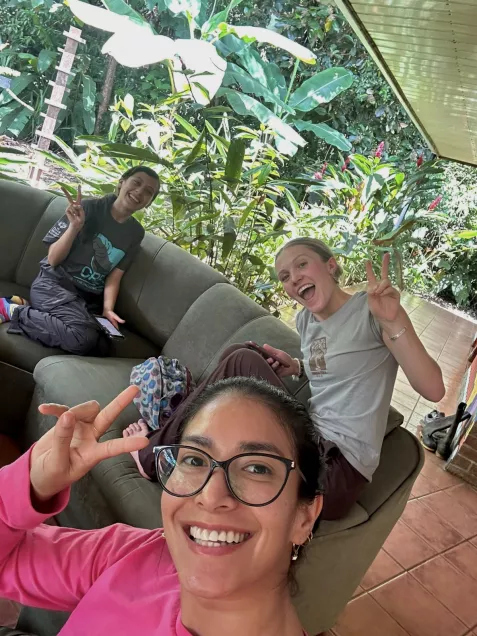
By Sydney Morris
Landscape Migratory Bird Monitoring Fellow, Osa Conservation, Costa Rica
Moving to Costa Rica right after graduating from Colorado College has been one of the biggest changes I’ve made in my life. With a minor in Spanish, I’ve always dreamt of living abroad, and didn't get the chance to study outside of the country in college due to COVID. Coupled with my B.A. in Organismal Biology & Ecology, the opportunity to work as an aspiring ornithologist (a.k.a. bird nerd) at Osa Conservation through Princeton in Latin America (PiLA) seemed like a perfect fit for my passions and career goals.
As a PiLA Fellow, I’ve navigated through various stages of adapting to a new culture, environment, and lifestyle, each stage teaching me something new about myself and how to overcome the obstacles presented by this wild place. In this blog, I look to humor you with my experience as a young adult who has been thrown into the jungle directly post-grad, in hopes of giving a few tips and tricks to those of you who may find yourself in a simiIar position. I call it “The 5 stages of being a PiLA Fellow” —the highs, the lows, and everything in between!
Stage 1: Holy s*** what did I get myself into?!
To be a PiLA Fellow, you might just have to be willing to live in the craziest, most remote, most biodiverse place you have ever seen! Before leaving home, I embraced my family, my comfy bed, and hot showers one last time, because the Osa Peninsula is NOT for the faint of heart. To survive at Osa Conservation, fellows must be willing to duel cockroaches nightly, withstand torrential downpours, and part ways with your favorite t-shirt that has succumbed to the mysterious jungle mold. Spending the past four years in Colorado as an avid skier and cold weather enthusiast, moving to the jungle was a complete 180. But I figured that if I hunkered down and stayed strong, I might really enjoy what comes next…
Stage 2: Trauma bonding leads to new friendships
Turns out, you're not the only one who has to experience this wild place! If you look around, everyone is taking on the same challenges, and struggles you face will make for great stories. You’ll eventually be able to laugh about the spider that woke you up at 2:00 AM and share stories like these with those around you. The seasoned veterans of this place will come to your rescue, and pass down the wisdom jungle living. This has helped me develop strong friendships with the volunteers, interns, and staff here at Osa Conservation.
Stage 3: Feeling adjusted and finding your groove
You made it! The most difficult part is over! Now that you’ve spent some time in the humidity, you’ll start to notice that you’re adjusting to this crazy place. After a month, Howler monkeys didn’t wake me up like they used to, and I started to learn how to identify the hundreds of bird songs surrounding me. Weekly meetings with my super awesome supervisor got me stoked about my project, and I started to see some incredible progress! My Spanish began to improve and I finally know what “mae” means. Soon enough, a greater appreciation for this wild place will start to grow. Outside of work, fellows may find they are a natural born surfer, or maybe even a talented karaoke singer. Whatever it may be, I have certainly picked up quite a few new hobbies here, including reading, running, and fussball. Little by little, this house will really start to feel like home.
Stage 4: New experiences
Once you’ve settled into your new life, you’ll start seeking out new adventures. The magic of living in such a biodiverse environment is that there’s always something new to discover. Whether it’s exploring new trails, spotting a Three-wattled Bellbird during bird surveys, or learning how to climb a massive tree to check camera traps with the wildlife team, every day brings a fresh experience that pushes you to grow, adapt, and see the world from a different perspective. Collaborating with other programs within Osa Conservation and local communities has also provided me with unforgettable experiences! The first time I relocated a nest of Olive Ridley sea turtle eggs and took kids birding in Puerto Jimenez are just a few of many memorable moments. These moments become the highlights of your fellowship, reminding you of the reasons you wanted to be here in the first place.
Stage 5: Home sweet home
Eventually, something clicks—you realize that despite the challenges and unpredictable nature of jungle life, you’ve fallen in love with this place. The immense beauty of the Osa Peninsula, the lifelong friendships I have made, and the sense of purpose I feel while working to protect this extraordinary ecosystem have all come together. The jungle has a way of getting under your skin, and soon enough, the thought of leaving feels bittersweet. What once seemed overwhelming and impossible is now home, and I guarantee the experiences you’ll have as a PiLA Fellow will stay with you for years to come.
Being a PiLA Fellow in Costa Rica has been nothing short of transformative. It’s an experience that has tested my resilience, deepened my appreciation for those working in conservation, and shown me the power of stepping out of my comfort zone. The Osa Peninsula, with its beauty and challenges, has shaped not only my life trajectory, but also how I view the world. If you ever find yourself in a similar situation, embrace it. The jungle may be unpredictable, but it’s in those unpredictable moments that the best memories are made.
